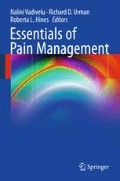Abstract
Cancer is the second leading cause of death in the United States after heart diseases. Center of Disease Control estimated number of cancer deaths in 2005 to 559,312. Cancer constitutes 22.8% of the total death in the United States. Lung cancer is the most common fatal cancer in men (31%), followed by colon and rectum (10%), and prostate (9%). In women, lung (26%), breast (15%), and colon and rectum (10%) are the leading causes of cancer death. Most patients with cancer have pain. Cancer pain can develop from tumor invasion, musculoskeletal pain, visceral pain, radiation treatment effect, or neuropathy from chemotherapy. The incidence of pain in cancer patients receiving active treatment for early disease is about 20–25%. The incidence of pain in cancer patient with advanced disease is about 90%. More than 50% of patients with cancer pain have only one or two locations of pain. This fact usually gives the opportunity for interventional pain doctors to help patients with pain. Many cancer patients present with a combination of pain types such as visceral and somatic pain. Up to 90% of cancer pain patients respond well to medical treatment. A high percentage of the remaining individuals also respond well to interventional pain techniques (Portenoy 1989).
Access this chapter
Tax calculation will be finalised at checkout
Purchases are for personal use only
References
Abram SE, ed. Pain management. In: Miller RD, editor. Atlas of anesthesia. Philadelphia, PA: Churchill Livingstone; 1998. Vol. 6.
Benedetti C, Brock C, Cleeland C, et al. NCCN practice guidelines for cancer pain. Oncology 2000;14:135–50.
Bennett G, Burchiel K, Buchser E, et al. Clinical guidelines for intraspinal infusion: report of an expert panel. J Pain Symptom Manage. 2000;20:S37–S43.
Berland D. Pain management in patients with advanced cancer. Ann Intern Med. 2000;132:593.
Burton AW, Driver LC, Mendoza TR, et al. Oral transmucosal fentanyl citrate in the outpatient management of severe cancer pain crises. Clin J Pain. 2004a;20:195–97.
Burton AW, Rajagopal A, Hassenbusch SJ, et al. Reduction in pain and oral opioid intake after intrathecal pump implantation. In: Program and abstracts of the International Association for the Study of Pain 10th World Congress on Pain, August 17–22, 2002, San Diego, CA.
Burton AW, Rajagopal A, Shah HN, et al. Epidural and intrathecal analgesia is effective in treating refractory cancer pain. Pain Med. 2004b;5:239–47.
Carr DB, Goudas LC, Balk EM, et al. Evidence report on the treatment of pain in cancer patients. J Nat Cancer Inst Monogri. 2004;32:23–31.
Cherny NI. The management of cancer pain. CA Cancer J Clin. 2000;50:70–116. Abstract
Davies DD. Incidence of major complications of neurolytic coeliac plexus block. J R Soc Med. 1993;86:264–266.
de Leon-Casasola OA. Critical evaluation of chemical neurolysis of the sympathetic axis for cancer pain. Cancer Control 2000;7:142–8.
Doggrell SA. Intrathecal ziconotide for refractory pain. Expert Opin Invest Drugs. 2004;13:875–77.
Eisenach JC, Du Pen S, Dubois M, et al. Epidural clonidine analgesia for intractable cancer pain. The Epidural Clonidine Study Group. Pain 1995;61:391–99.
Eisenberg E, Carr DB, Chalmers TC. Neurolytic celiac plexus block for treatment of cancer pain: a meta-analysis. Anesth Analg. 1995;80:290–5.
Erdine S, Talu GK. Cost effectiveness of implantable devices versus tunneled catheters. Curr Rev Pain. 1998;2:157–62.
Fukshansky M, Are M, Burton AW. The role of opioids in cancer pain management. Pain Pract. 2005;5:43–54.
Gilmer-Hill HS, Boggan JE, Smith KA, et al. Intrathecal morphine delivered via subcutaneous pump for intractable cancer pain: a review of the literature. Surg Neurol. 1999;51:12–5.
Jacox AK, Carr DB, Payne R, et al. Management of cancer pain: clinical practice guideline No. 9. Rockville, MD: Agency for Healthcare Policy and Research, US Department of Health and Human Services, Public Health Service; 1994: AHCPR Publication No. 94-0592.
Miguel R. Interventional treatment of cancer pain: the fourth step in the World Health Organization analgesic ladder? Cancer Control 2000;7:149–56.
Patt RB. Cancer pain. Philadelphia, PA: Lippincott; 1993.
Plancarte R, de Leon-Casasola OA, El-Helay M, et al. Neurolytic superior hypogastric plexus block for chronic pelvic pain associated with cancer. Reg Anesth. 1997;22:562–8.
Portenoy RK. Cancer pain: epidemiology and syndromes. Cancer 1989;63(11 suppl): 2298–307.
Shah HN, Burton AW, Mendoza T, et al. Neurolytic blockade of the splanchnic nerves block relieves refractory pain associated with upper abdominal malignancy. In: Program and Abstracts of the Annual Meeting of the American Society of Anesthesiologists; October 11–15, 2003, San Francisco, CA; Abstract A1024.
Stoelting RK, Miller RD. Spinal and epidural anesthesia. In: Stoelting RK, Miller RD, editors. Basics of anesthesia. Philadelphia, PA: Churchill Livingstone; 2000. pp. 168–95.
Waldman SD. Interventional pain management. Phildelphia, PA: Saunders; 2001.
Wong GY, Brown DL. Celiac plexus block for cancer pain. In: Utney W, editor. Techniques in regional anesthesia and pain management. Vol. 1. Philadelphia, PA: W.B. Saunders; 1997.
World Health Organization. Cancer pain relief and palliative care: report of a WHO expert committee. WHO Tech Rep Ser. 1990;804:1–73.
Zech DFJ, Grond S, Lynch J, et al. Validation of World Health Organization Guidelines for cancer pain relief: a 10-year prospective study. Pain 1995;63:65–76.
Author information
Authors and Affiliations
Editor information
Editors and Affiliations
Rights and permissions
Copyright information
© 2011 Springer Science+Business Media, LLC
About this chapter
Cite this chapter
Atallah, J.N. (2011). Management of Cancer Pain. In: Vadivelu, N., Urman, R., Hines, R. (eds) Essentials of Pain Management. Springer, New York, NY. https://doi.org/10.1007/978-0-387-87579-8_28
Download citation
DOI: https://doi.org/10.1007/978-0-387-87579-8_28
Published:
Publisher Name: Springer, New York, NY
Print ISBN: 978-0-387-87578-1
Online ISBN: 978-0-387-87579-8
eBook Packages: MedicineMedicine (R0)

